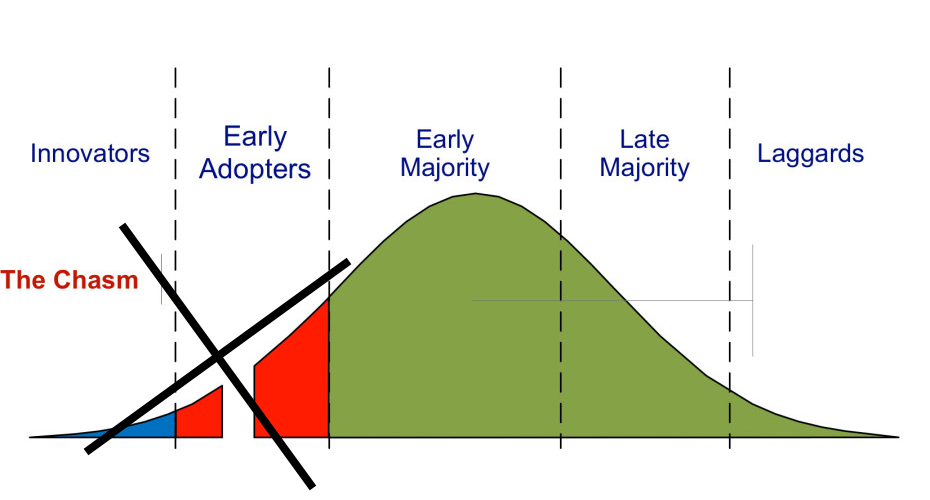
Diffusion Framework Confusion
- Post by: DRI Staff
- March 1, 2023
- Comments off
A recent analysis of 250 independent online book reviews, articles and publications by the research team at Predictable Innovation Strategy indicates widespread misunderstanding of the concept called “crossing the chasm,” which is an adaptation of Diffusion of Innovations. Six key areas were identified as the greatest sources of chasm framework confusion.
Built-In Weaknesses
The researchers identified three sources of misunderstanding that have contributed to the widespread confusion that exits today: criticism by Everett Rogers, an incorrect diagram that is very popular, and the changes in definition of the word disruptive.
Criticism by Everett Rogers – Soon after the chasm theory was published, Everett Rogers criticized the concept saying it was invalid. Rogers was quoted as saying: “Past research shows no support for this claim of a “chasm” between certain adopter categories. On the contrary, innovativeness, if measured properly, is a continuous variable. There are no sharp breaks or discontinuities between adjacent adopter categories (although there are important differences between them)”[1].
A misleading diagram – A popular diagram, in widespread use since 2009, misplaces the location of the chasm, and implies that early adopters are on BOTH sides of the chasm.

Multiple definitions of the term disruptive – Prior to the publishing of a book in 1997 called The Innovator’s Dilemma, the term “disruptive innovation” was well known and understood. Since 1997, that phrase now has multiple meanings, and the new definition is being applied incorrectly to the chasm framework.
Six Areas of Widespread Chasm Framework Confusion
Rogers’ criticism undoubtedly created substantial uncertainty and doubt, and increased the amount of chasm framework confusion. However, the research project went beyond built-in weaknesses that have plagued the chasm framework, and identified six key areas where confusion is the most widespread:
1. Mischaracterizing an innovation: There is a big difference between a novel innovation and a simple refinement. Most refinements are already in the mainstream, in which case there is no chasm.
2. Believing innovation only comes from startups: The chasm concept isn’t just for startups. Established market leaders or “incumbents” are able to develop novel innovations too.
3. Thinking that applications and technologies are the same thing – the innovation-adoption curve (with or without a chasm) only applies to applications, and NOT to technologies.
4. Assuming people stay in one category – a person can be an early adopter of a SaaS innovation and a late adopter (or even laggard) of a biological innovation.
5. Applying chasm theory to low-cost consumer products – chasm theory was originally developed in 1989 specifically to address the needs of emerging high-tech companies.[2] And more specifically, it was created for high-risk or high cost technology-based products that require new learning or a change in behavior.
6. Assuming chasm theory applies equally well in all industries – chasm principles are more difficult to apply in industries such as CleanTech. This often happens when government subsidies completely overwhelm the innovation-adoption process.
When business managers and leaders decide to use a model or framework for strategic guidance, the model needs to be crystal clear. Any ambiguity will lead to serious loss or delay of revenue.
It’s disappointing to hear so many “experts” interpret basic chasm concepts incorrectly. These errors propagate through thousands of unsuspecting executives, managers, and founders.
Unfortunately, the results of this research project show that 90% of the top-ranked, chasm-focused articles and book reviews on the Internet contain serious errors and mistakes.
In addition, the misunderstandings listed above appear in literature over and over again. These recurring errors contribute to widespread chasm framework confusion.
For more information, please contact us at: [email protected]
Link to Association of International Product Marketing and Management article: “It’s Not a Chasm; It’s a Continuum“
Footnotes

It’s Not a Chasm; It’s a Continuum
The Association of International Product Marketing and Management takes a deeper look at Rogers’ "Diffusion of Innovation" theory.
Chasm Theory Development
A 4-year study to reduce confusion and help students gain a clearer understanding of the chasm framework and its applications.
